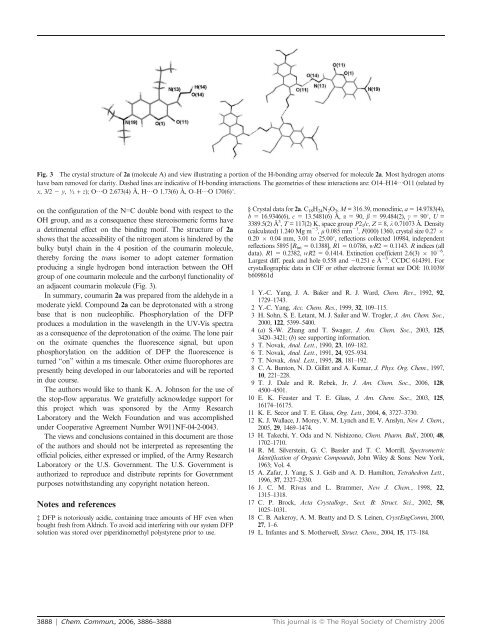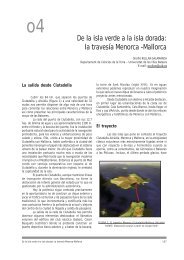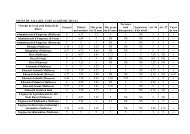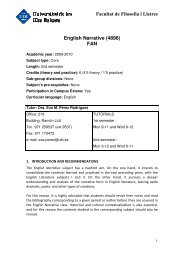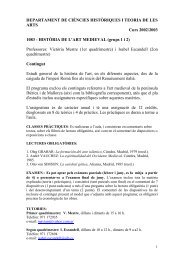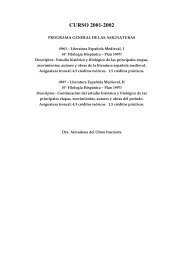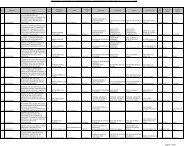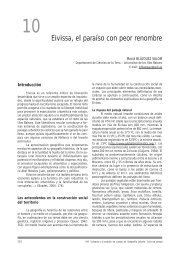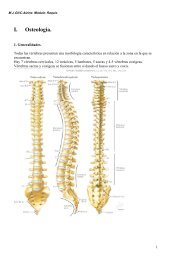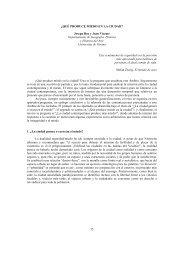View - Universitat de les Illes Balears
View - Universitat de les Illes Balears
View - Universitat de les Illes Balears
You also want an ePaper? Increase the reach of your titles
YUMPU automatically turns print PDFs into web optimized ePapers that Google loves.
Fig. 3 The crystal structure of 2a (molecule A) and view illustrating a portion of the H-bonding array observed for molecule 2a. Most hydrogen atoms<br />
have been removed for clarity. Dashed lines are indicative of H-bonding interactions. The geometries of these interactions are: O14–H14 … O11 (related by<br />
x, 3/22 y, K + z); O … O2.673(4)A˚ ,H … O1.73(6)A˚ ,O–H … O170(6)u.<br />
on the configuration of the NLC double bond with respect to the<br />
OH group, and as a consequence these stereoisomeric forms have<br />
a <strong>de</strong>trimental effect on the binding motif. The structure of 2a<br />
shows that the accessibility of the nitrogen atom is hin<strong>de</strong>red by the<br />
bulky butyl chain in the 4 position of the coumarin molecule,<br />
thereby forcing the trans isomer to adopt catemer formation<br />
producing a single hydrogen bond interaction between the OH<br />
group of one coumarin molecule and the carbonyl functionality of<br />
an adjacent coumarin molecule (Fig. 3).<br />
In summary, coumarin 2a was prepared from the al<strong>de</strong>hy<strong>de</strong> in a<br />
mo<strong>de</strong>rate yield. Compound 2a canbe<strong>de</strong>protonatedwithastrong<br />
base that is non nucleophilic. Phosphorylation of the DFP<br />
produces a modulation in the wavelength in the UV-Vis spectra<br />
as a consequence of the <strong>de</strong>protonation of the oxime. The lone pair<br />
on the oximate quenches the fluorescence signal, but upon<br />
phosphorylation on the addition of DFP the fluorescence is<br />
turned ‘‘on’’ within a ms timescale. Other oxime fluorophores are<br />
presently being <strong>de</strong>veloped in our laboratories and will be reported<br />
in due course.<br />
The authors would like to thank K. A. Johnson for the use of<br />
the stop-flow apparatus. We gratefully acknowledge support for<br />
this project which was sponsored by the Army Research<br />
Laboratory and the Welch Foundation and was accomplished<br />
un<strong>de</strong>r Cooperative Agreement Number W911NF-04-2-0043.<br />
The views and conclusions contained in this document are those<br />
of the authors and should not be interpreted as representing the<br />
official policies, either expressed or implied, of the Army Research<br />
Laboratory or the U.S. Government. The U.S. Government is<br />
authorized to reproduce and distribute reprints for Government<br />
purposes notwithstanding any copyright notation hereon.<br />
Notes and references<br />
{ DFP is notoriously acidic, containing trace amounts of HF even when<br />
bought fresh from Aldrich. To avoid acid interfering with our system DFP<br />
solution was stored over piperidinomethyl polystyrene prior to use.<br />
§ Crystal data for 2a.C 18H 24N 2O 3, M = 316.39, monoclinic, a 5 14.9783(4),<br />
b 5 16.9346(6), c 5 13.5481(6) A˚ , a 5 90, b 5 99.484(2), c 5 90u, U =<br />
3389.5(2) A˚ 3 , T = 117(2) K, space group P21/c, Z =8,l 0.71073 A˚ .Density<br />
(calculated) 1.240 Mg m 23 , m 0.085 mm 21 , F(000) 1360, crystal size 0.27 6<br />
0.20 6 0.04 mm, 3.01 to 25.00u, reflections collected 10984, in<strong>de</strong>pen<strong>de</strong>nt<br />
reflections 5895 [R int 5 0.1388], R1 5 0.0786, wR2 5 0.1143. R indices (all<br />
data). R1 5 0.2382, wR2 5 0.1414. Extinction coefficient 2.6(3) 6 10 26 .<br />
Largest diff. peak and hole 0.558 and 20.251 e A˚ 23 . CCDC 614391. For<br />
crystallographic data in CIF or other electronic format see DOI: 10.1039/<br />
b609861d<br />
1 Y.-C. Yang, J. A. Baker and R. J. Ward, Chem. Rev., 1992, 92,<br />
1729–1743.<br />
2 Y.-C. Yang, Acc. Chem. Res., 1999, 32, 109–115.<br />
3 H. Sohn, S. E. Letant, M. J. Sailer and W. Trogler, J. Am. Chem. Soc.,<br />
2000, 122, 5399–5400.<br />
4 (a) S.-W. Zhang and T. Swager, J. Am. Chem. Soc., 2003, 125,<br />
3420–3421; (b) see supporting information.<br />
5 T. Novak, Anal. Lett., 1990, 23, 169–182.<br />
6 T. Novak, Anal. Lett., 1991, 24, 925–934.<br />
7 T. Novak, Anal. Lett., 1995, 28, 181–192.<br />
8 C. A. Bunton, N. D. Gillitt and A. Kumar, J. Phys. Org. Chem., 1997,<br />
10, 221–228.<br />
9 T. J. Dale and R. Rebek, Jr, J. Am. Chem. Soc., 2006, 128,<br />
4500–4501.<br />
10 E. K. Feuster and T. E. Glass, J. Am. Chem. Soc., 2003, 125,<br />
16174–16175.<br />
11 K. E. Secor and T. E. Glass, Org. Lett., 2004, 6, 3727–3730.<br />
12 K.J.Wallace,J.Morey,V.M.LynchandE.V.Anslyn,New J. Chem.,<br />
2005, 29, 1469–1474.<br />
13 H. Takechi, Y. Oda and N. Nishizono, Chem. Pharm. Bull., 2000, 48,<br />
1702–1710.<br />
14 R. M. Silverstein, G. C. Bassler and T. C. Morrill, Spectrometric<br />
I<strong>de</strong>ntification of Organic Compounds, John Wiley & Sons: New York,<br />
1963;Vol.4.<br />
15 A. Zafar, J. Yang, S. J. Geib and A. D. Hamilton, Tetrahedron Lett.,<br />
1996, 37, 2327–2330.<br />
16 J. C. M. Rivas and L. Brammer, New J. Chem., 1998, 22,<br />
1315–1318.<br />
17 C. P. Brock, Acta Crystallogr., Sect. B: Struct. Sci., 2002, 58,<br />
1025–1031.<br />
18 C. B. Aakeroy, A. M. Beatty and D. S. Leinen, CrystEngComm, 2000,<br />
27, 1–6.<br />
19 L. Infantes and S. Motherwell, Struct. Chem., 2004, 15, 173–184.<br />
3888 | Chem. Commun., 2006, 3886–3888 This journal is ß The Royal Society of Chemistry 2006


